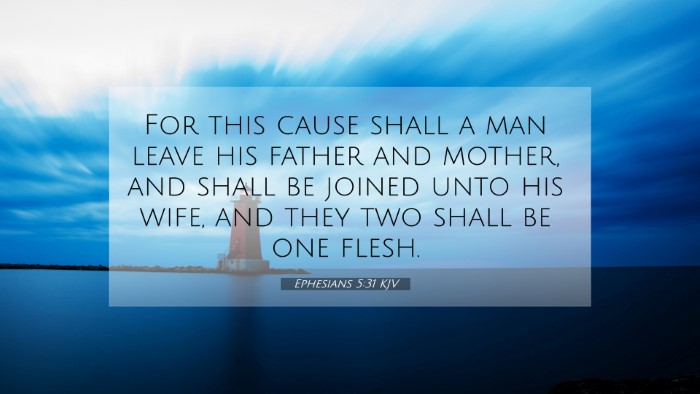Ephesians 5:31 Explained
Ephesians 5:31 states, "For this reason a man shall leave his father and mother and be joined to his wife, and the two shall become one flesh." This verse highlights the sanctity of marriage, emphasizing the significance of the union between husband and wife.
Meaning and Interpretation
The phrase "for this reason" signifies a deep-rooted principle that finds its origins in the creation narrative, reflecting God’s intended design for marriage.
- Leaving Parents: The first step signifies a clear shift of focus from the parental relationship to the marital relationship. This separation illustrates the prioritization of the marital bond.
- Joining Together: The term "joined" conveys an active commitment to unite, which entails both physical and emotional elements, indicating a holistic partnership.
- One Flesh: This phrase encapsulates the depth of intimacy and unity found within the marriage covenant. It denotes not just physical union but emotional and spiritual harmony as well.
Commentary Insights
Various public domain commentaries provide rich insights into this passage:
- Matthew Henry: Henry emphasizes the divine ordinance of marriage, pointing out that this union is a reflection of Christ’s relationship with the Church. He notes that this passage reflects the intended permanence and intimate nature of the marital bond.
- Albert Barnes: Barnes signifies that the leaving of parents and the joining together highlights a transformative process in a man's life where familial ties are redefined through marriage. He underscores the cultural importance of this union in society.
- Adam Clarke: Clarke notes the theological implications of "one flesh", explaining that this represents the physical and spiritual unity established by God. He also comments on the implications for the roles within marriage.
Bible Verse Cross-References
This verse relates to several other scriptures which further illuminate its meaning:
- Genesis 2:24: "Therefore a man shall leave his father and mother and be joined to his wife, and they shall become one flesh." This is the original source of Ephesians 5:31, illustrating the foundation of marital unity.
- Matthew 19:5-6: Jesus reiterates the importance of this union, affirming that what God has joined together, let not man separate.
- 1 Corinthians 6:16: Paul emphasizes the profound connection of becoming "one flesh" in a marital relationship, linking it with the relationship of Christ and the Church.
- Colossians 3:18-19: This passage offers instruction on the relational dynamics within marriage, promoting mutual respect and love.
- Malachi 2:14: The Old Testament perspective on the covenant nature of marriage, reinforcing the seriousness of the marital commitment.
- Hebrews 13:4: A reminder of the honor of marriage and the call to keep the marriage bed undefiled.
- Ephesians 5:28: Discusses the care a husband should have for his wife, paralleling the love Christ has for the Church.
- 1 Peter 3:7: Instructs husbands to understanding and honor their wives, recognizing them as co-heirs of the grace of life.
- Romans 7:2-3: Explores the binding nature of marriage in the context of the law, underscoring its seriousness.
- Song of Solomon 8:6-7: Captures the passionate and enduring love that marriage ought to embody.
Tools for Bible Cross-Referencing
To enhance your understanding of Ephesians 5:31 and its connections, consider using the following tools:
- Bible Concordance: A reference tool that lists words in the Bible and their occurrences for contextual study.
- Bible Cross-Reference Guide: A resource that provides related passages to explore thematic connections.
- Bible Reference Resources: Various online and print resources that assist in exploring biblical texts and themes.
- Bible Chain References: A methodical approach to linking verses and themes across scripture.
- Comprehensive Bible Cross-Reference Materials: Includes studies and commentaries that explore inter-Biblical dialogue.
How to Use Bible Cross-References
To effectively utilize cross-references when studying verses like Ephesians 5:31, consider the following steps:
- Identify Key Themes: What central concepts are highlighted in the verse (e.g., unity, covenant, holiness)?
- Research Related Verses: Use Bible concordances or cross-reference tools to find verses that correspond to these themes.
- Compare Contexts: Consider each verse’s context to grasp how they interact thematically.
- Create a Study Framework: Establish how these interconnected verses inform one another and enhance your understanding of scripture as a whole.
Conclusion
Understanding Ephesians 5:31 transcends its surface meaning, inviting believers to engage with the rich scriptural tapestry that unfolds around the theme of marriage. By navigating through cross-referenced Bible verses, one can appreciate the profound, covenantal nature of relationships as God intended.






